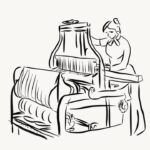Stop Killing Us: A Study of Lesbian Representation in the Media
By Olivia Agostini
The lesbian community has become more visible than ever, yet visibility does not mean acceptance. Queer women still struggle for rights in the workplace, in their own homes, and even out on the streets. Women, as portrayed by the media, are generally seen as the “damsel in distress” or the less important “sidekick” of the male lead. However, when the woman is queer, it becomes difficult to fit them into these stereotypical categories, thus they are sexualized or belittled by other characters and the audience. Closer examination of lesbians in the media reveals social expectations, stereotyping, and homophobia to be leading the United States toward a mass genocide of this group.
The world is filled with social expectations; whether within one’s home or in the public eye, there is a high bar set by the media for how women are expected to behave. This is no different for the lesbian community. A woman is expected to be a nurturing, motherly figure who takes care of her household, husband, and children, while simultaneously maintaining a passive femininity that does not challenge the masculinity of superior male figures. In some ways, she is still expected to act like a typical housewife from the 1950’s, and many lesbians simply cannot fill this role. A typical lesbian couple may act similar to a husband and wife, but more often than not they share the roles and responsibilities of the house. There is not one person in the relationship who does all of the unpaid housework while the other works a full-time job. In fact, both women may have full-time jobs, but they will still take care of their home equally: one may do the cooking while the other cleans up, one watches the children (if they have any) while the other shops for groceries, one does the taxes while the other gives the family car an oil change.
They may switch duties on a weekly or even daily basis. Lesbians are looked down upon by more traditional thinkers such as Billy Graham, who argued only a man makes a functional home. Or staunch Catholics. Lesbian women, by not conforming to traditional men or women’s roles, completely shatter all expectations previously set for them, such as Hannah Wyland in the series Quantico. However broken these shattered expectations are, they are not completely lost. The pieces alter and change, mixing and matching, and becoming more widespread, transforming into something more than just an expectation: a stereotype.
According to Sheng Kuan Chung, a professor from the University of Houston College of Education, “Stereotyping is a cognitive process by which humans simplify complex information and make sense of the world”.[1] Stereotyping, whether conscious or not, obviously affects how the media portrays lesbians. My examination reveals that every time there is a queer woman in the media, she is thrown into one of the following categories: sexual pleasure for a male audience, a girl who’s given up on men because she just “hasn’t found the right guy,” or a “butch chick” who is only there for a punchline. These categories not only limit the representation of real-life lesbians, but also are insulting and generalized. According to The Celluloid Closet, a documentary from 1995 about gay and lesbian representation in the media, “In a hundred years of movies, homosexuality has only rarely been depicted on the screen. When it did appear, it was there as something to laugh at, or something to pity, or even something to fear.”[2]
The sexual representation of lesbians in the media is unduly skewed. Whenever one searches for lesbian media, they are likely to come across pornographic content. If lesbians are not being fairly represented, why is there so much porn? One may think that it exists to satisfy the lesbian audience in a sexual manner, but this is not the case. The abundance of lesbian porn exists to appeal to a heterosexual male audience. But why actively seek out lesbian porn if they are not a part of the lesbian community? As stated by Ann M. Ciasullo, a published author of Feminist Studies, “The mainstream lesbian body… is made into an object of desire for straight audiences through her heterosexualization.”[3] If a heterosexual man watches a pornographic scene between a man and a woman, he gets pleasure by observing the woman, but is distracted by the man. Porn is all about fantasizing, and when there is a man present with the woman being fantasized about, the observer may find it difficult to continue picturing himself in that position. Whereas, with a pornographic lesbian film, the whole thing is flipping between the two female actors. Therefore, there is no depersonalization.
So the question remains: why is this a bad thing? The act of watching porn itself is not harmful to the lesbian community, but the attitudes that come with watching it are. When the vast majority of lesbians in the media are seen only in pornography, it sends a clear message to the heterosexual male audience: lesbians are sexual objects. They are not viewed in the same light as heterosexual women, and are treated differently as a result.
Another type of stereotypical lesbian displayed in the media is one who is characterized as “an angry, dominating, defensive, and humorless person, who [is] also seen as being masculine and unattractive in appearance.”[4] She may be shown to be combative, even violent, and characters fear her. When she leaves the screen with her smaller, quieter, more feminine partner, other characters will make a rude comment, sometimes direct insults, but more often than not, a statement equating the woman’s aggressive behavior to her sexuality, followed by a laugh track.
The so-called “dyke” stereotype makes it seem as if any lesbian who is not dating one of these butch women must be one of them; it throws a sort of “heterosexual veil” over their relationship. The butch woman acts as the man of the relationship, the other woman being the “real” woman, rather than simply being two women in a relationship. The fear factor is especially harmful to this community of women. Showing the other characters being afraid of the lesbian may influence the audience to fear them as well. With this fear, there is homophobia, and with homophobia, there is violence.
In an annual report published by the Gay and Lesbian Alliance Against Defamation,[5] it was discovered that during the 2016-2017 broadcast season, there were only twelve regular and recurring lesbian characters out of the 895 studied through 118 primetime scripted shows. This is a very small list for a study of five different broadcasting networks, and this lack of representation has a great effect on the community as a whole. Another study performed by the American Association of Suicidology revealed lesbian and gay youth to be “three times more likely to report thoughts of suicide than their heterosexual counterparts.”[6]
The simple lack of representation is not the cause of this increasing rate in suicide. However, it is directly related to the treatment of the few queer characters who are shown in the media. According to Mic Emslie, author of Ignored to death, “It has long been noted that there is a higher prevalence of suicide, suicide attempts and suicidal ideation among North American gay and lesbian young people.”[7] In recent years, the “Bury Your Gays” trope has become quite common in popular media. What does “Bury Your Gays” mean? According to tvtropes.org, it is when a queer character appears in any form of media, and is then killed off, usually in an undignified manner.
Take the popular TV show The 100, for example: a character named Lexa was introduced in season two, episode six. The actress, Alycia Debnam-Carey, was revealed to be a guest star, meaning that she would not remain on the show for a long period of time.[8] When Lexa’s character was revealed to be queer, fans expressed concern over her guest status, but the creators of the show insisted that they were a queer-friendly program. This proved to untrue as Lexa was shot and killed by a stray bullet in season three, episode seven.[9] This not only displays the “Bury Your Gays” trope in its rawest form, but also an extreme example of Queerbaiting.
Queerbaiting is a subject all on its own, defined as “the perceived attempt by…creators (typically of television shows) to woo queer fans… , but with no intention of actually showing a gay relationship being consummated on screen.”[10] This is done through creating queer characters and killing them off after gathering a large queer audience, and simply by building romantic and/or sexual tension between two same-gendered characters without actually portraying a relationship between them.
In a report published by Nigel Morris, Deputy Political Editor of The Independent, 5,597 hate crimes against homosexual people were reported in 2014-2015, “a rise of 22 per cent on the previous 12 months,”[11] but what does this have to do with representation in the media? In short, the “Bury Your Gays” trope has begun seeping out of the digital world and into the real world.
As a homosexual woman bleeds out on the television screen, another is quite literally bleeding out in the street. Almost everyone is influenced by the media, whether they realize it or not, and those who initiate these “hate crimes” are no exception. As viewers are shown countless examples of objectified, confused, and terrifying lesbians on TV, they begin to think of ways to eliminate the problem. The solution: rid themselves of these dangerous women; eradicate the lesbians.
While social expectations and stereotypes play a role in how lesbians appear in the media, it is this very representation that is spreading homophobic ideals culturally in the United States. As the United States becomes more homophobic, more lesbians will fall victim to these vicious hate crimes. The lesbian community is experiencing a massacre due to the sheer number of fatal hate crimes against homosexuals, caused indirectly by the lack of positive representation of gay women in today’s media, and if this does not change soon, the lesbians of America will be well on their way to genocide.”
[1] Chung, Media Literacy Art Education: Deconstructing Lesbian and Gay Stereoptypes in the Media, 99.
[2] Epstein, The Celluloid Closet, 2006.
[3] Ciasullo, Making Her (In)visible: Cultural Representations of Lesbianism and the Lesbian Body in the 1990’s, 577.
[4] Geiger, College Students’ Multiple Stereotypes of Lesbians: A Cognitive Perspective.
[5] Stokes, Where We Are on TV, glaad.org.
[6] Suicidal Behavior Among Lesbian, Gay, and Bisexual Youth. American Association of Suicidology. 2016.
[7] Emslie, Ignored to Death, 38.
[8] The 100, “Fog of War.” Season Two, Episode Six. Directed by Steven DePaul. Written by Kira Snyder. The CW. December 3, 2014
[9] The 100. “Thirteen.” Season Three, Episode Seven. Directed by Dean White. Written by Javier Grillo-Marxuach. The CW. March 3, 2016.
[10] Organization for Transformative Works. “Queer Baiting.” fanlore.org
fanlore.org/wiki/Queer_Baiting.
[11] Morris, Nigel. “Figures reveal a ‘shocking’ rise in homophobic hate crimes.” The Independent. October 13, 2015.
References
Chung, Sheng K. “Media Literacy Art Education: Deconstructing Lesbian and Gay Stereotypes
in the Media.” International Journal of Art & Design Education, vol. 26, pp. 98-107. 22 Jan. 2007
Ciasullo, Ann M. “MAKING HER (IN)VISIBLE: CULTURAL REPRESENTATIONS OF
LESBIANISM AND THE LESBIAN BODY IN THE 1990s.” Feminist Studies, vol. 27, pp. 577. Autumn, 2001
Emslie, Mic. “Ignored to death.” Youth Studies Australia, vol. 15, pp.38. January, 1996
Epstein, Rob, et al. The Celluloid Closet. Sony Pictures Classics, 2006.
Geiger, Wendy, et al. “College Students’ Multiple Stereotypes of Lesbians: A Cognitive
Perspective.” Journal of Homosexuality, vol. 51, pp. 165-182. 11 October 2006
Grillo-Marxuach, Javier. “Thirteen.” The 100, season 3, episode 7, The CW, 3 Mar. 2016.
Morris, Nigel. “Figures reveal a ‘shocking’ rise in homophobic hate crimes.” The Independent,
Independent Digital News and Media, 13 Oct. 2015.
“Queer Baiting.” Queer Baiting – Fanlore, fanlore.org/wiki/Queer_Baiting.
Snyder, Kira. “Fog of War.” The 100, season 2, episode 6, The CW, 3 Dec. 2014.
Stokes, Zeke, et al. Where We Are on TV. GLAAD, 2017, Where We Are on TV,
glaad.org/files/WWAT/WWAT_GLAAD_2016-2017.pdf.
SUICIDAL BEHAVIOR AMONG LESBIAN, GAY, AND BISEXUAL YOUTH [PDF]. (2016). American Association of Suicidology.








